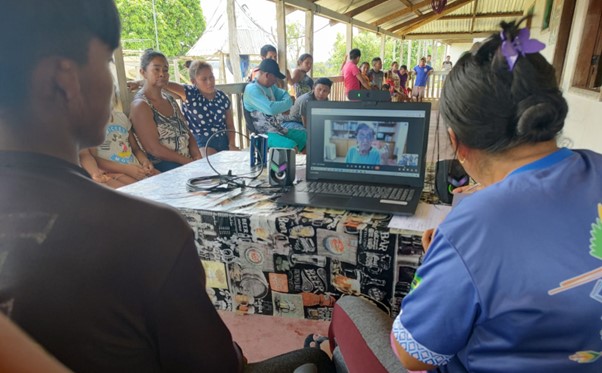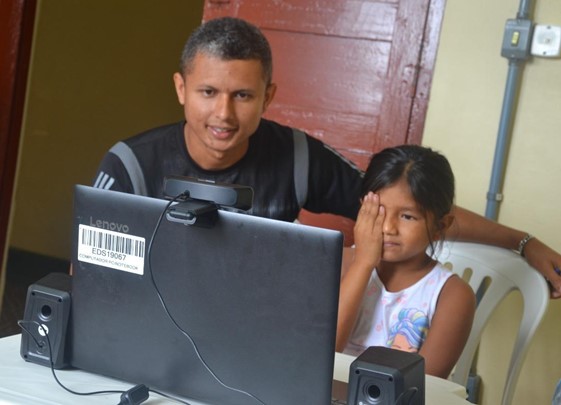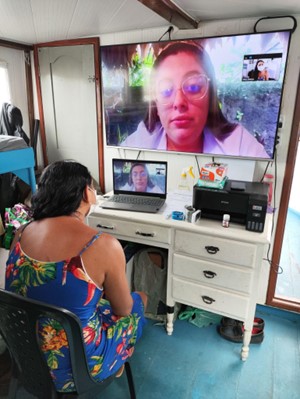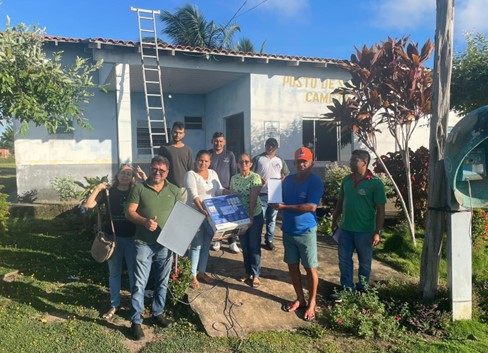Success Story
Health Beyond Distance: Pioneering Use of Telemedicine Transforms the Reality of Amazonian Communities
December 12, 2023
Through the USAID-funded New Partnerships Initiative (NPI) EXPAND Brazil project, implementation partners worked to increase vaccination against COVID-19 in the Amazon region. In Brazil, NPI EXPAND supports projects dedicated to facing the COVID-19 pandemic and promoting the immunization of vulnerable and isolated communities. These projects show how collaboration among the public, private, and social sectors can encourage capacity strengthening, promote innovation, and improve essential public services, such as the Unified Health System (Sistema Único de Saúde (SUS)) in Brazil.

Indigenous peoples from remote villages receive care and attention through telemedicine. Photo: EDS
The Amazon region, renowned as one of the world’s most biodiverse areas, holds exceptional significance as a cultural and ecological hub in Brazil. Despite this, the region faces serious challenges, particularly concerning access to healthcare services.
The vast distances between communities and a lack of infrastructure result in the isolation of entire populations, making it more difficult to deliver medical care due to the scarcity of health workers. However, different telemedicine strategies have helped to overcome these barriers, allowing the Amazonian people to benefit from remote medical assistance and expertise. Without this new tool, people in remote communities would be faced with having to undertake long journeys to receive care, leaving work or family behind, or not receiving the care they need at all.
The COVID-19 pandemic created an urgent need to combat the novel virus and triggered the widespread adoption of telemedicine worldwide. In Brazil, telemedicine was provisionally regulated in 2020, and in December 2022, it was permanently regulated by Law 14.510/22, which formalized the practice. There are many different telemedicine models, but all incorporate some use of teleconferencing to facilitate diagnosis, treatment, provider training, scheduling of appointments or referrals, and other steps in the continuum of care. If this process facilitates healthcare access in major urban centers, just imagine its impact on those living in riverside communities, quilombola settlements, or indigenous villages deep in the heart of the Amazon Rainforest.
Innovation Delivering Health
Numerous projects supported by NPI EXPAND Brazil have found telemedicine to be a means of extending aid and providing ongoing medical support to various communities.

Indigenous child receiving a telemedicine eye checkup. Photo: EDS
Even amidst the overall decline in COVID-19 cases and a decrease in severe cases due to a higher number of vaccinated individuals, telemedicine remains a valuable tool for treating patients dealing with post-COVID conditions and identifying vaccination needs.
“To think of medical care in the Amazon region without including organized telemedicine is to overlook a powerful tool for local healthcare,” says Eliél Martins, a nurse from the nongovernmental organization Expedicionários da Saúde (EDS).
Martins is one of the health workers involved in the “Operando na Amazônia” (Operating in the Amazon) project, implemented by EDS in remote Indigenous lands. The project involves sending health teams to these areas and setting up a complete surgical care complex on-site. Telemedicine was incorporated to ensure continuous care even after the in-person visit or during pandemic-related restrictions.
Similarly, the “Inspirar Saúde” (Inspire Health) project, executed by Doutores da Amazônia (DRA), also brought innovation to indigenous territories in the Amazonian states. During their expeditions to these secluded locations, health workers provided boards with QR codes for scheduling remote consultations. In addition to virtual care, the project also trained Indigenous health agents through an online platform, creating a valuable bridge between Indigenous communities and specialists.
Dr. Caio Eduardo Machado, president of DRA, states that, “the connection is already established; we have conducted hundreds of consultations, providing guidance, strengthening, and referring patients. Today, we believe telemedicine is our most powerful tool to reach places that were once very distant.” The project enabled the formation of a team of specialists to conduct training and consultations, further solidifying its effectiveness.

A small room on the boat of the Rios da Esperança project provides space for online medical consultations. Photo: CBASMA
Telemedicine has even made its way to people living along the Amazon River aboard a boat that sailed the river with the project “Rios da Esperança –Arte e Saúde contra a COVID-19” (Rivers of Hope – Art and Health against COVID-19). This initiative, implemented by the Brazilian Company of Arts, Society, and the Environment (CBASMA), transported art and healthcare between Belém do Pará and Manaus, promoting COVID-19 vaccination.
By navigating the river, the project was able to reach remote riverside communities and leveraged telemedicine to provide medical care to them. Inside the boat “O Marujo,” a medical consultation room was set up, focusing on cases of suspected COVID-19 and long COVID.
“We ventured through the Amazonian igarapés [narrow watercourses or streams in the Amazon region], reaching communities that had been without access to comprehensive medical services for many years,” says André Monteiro, the project’s founder and general coordinator. Reaching some communities can take a full week or more, especially during the dry season when rivers are less navigable.
Inland, to overcome the vast distances and lengths of the municipalities of Altamira, Santarém, Belterra, and Aveiro in Western Pará, the project “Ações Sinérgicas e Cooperativas de Mitigação do Covid-19 no Tapajós e Bacia do Xingu” (Synergistic and Cooperative Actions for COVID-19 Mitigation in Tapajós and Xingu Basin) installed ten telemedicine hubs. This initiative, carried out by Projeto Saúde e Alegria (PSA) in partnership with SAMA Health Harmony, aims to minimize the challenges of providing healthcare services in remote areas, as emphasized by Fábio Tozzi, doctor and coordinator of PSA.
“Telemedicine represents an inclusive modality and is part of a much broader strategy within the Sistema Único de Saúde (SUS – Unified Health System). It is a promising program for the Amazon region, which is considered a frontline in telehealth assistance,” Tozzi explains.
A New Technology That Drives New Strategies

Project in Western Pará receives electronic equipment to set up one of the telemedicine hubs. Photo: PSA.
Many of these projects already utilize a new mobile internet technology called Starlink. This resource eliminates the need for cables and fiber optics to provide internet access as it uses connections via satellites closer to Earth, delivering stable and high-speed connectivity. Additionally, equipment to access this connectivity is small and light enough to be easily carried to remote communities.
Access to and usage of Starlink technology is celebrated, but new models for taking advantage of this capacity have to be developed. Additionally, health professionals will need to explore new ways of working with innovative technologies and standards of practice. For Tozzi, after overcoming the barriers created by technology, the next step is the maintenance of the telemedicine hubs. “The goal is to have the entire project integrated into the SUS, ensuring the continuity of services,” he says.
Some projects, like those of DRA and CBASMA, were executed before the arrival of the Starlink resource, resulting in additional challenges due to low internet signals in certain locations, especially in Indigenous and riverside communities. However, despite these difficulties, the dedicated efforts to expand the reach of these projects have been equally valuable.
The project’s ability to adapt telemedicine in various ways according to the specific needs of the communities demonstrates the versatility and applicability of this technology. The use of telemedicine represents a powerful new tool in making healthcare and health promotion more accessible to Indigenous communities of the Amazon. NPI EXPAND’s local partners have tested different models and uses of telemedicine that others can follow and build on in the future. Continuous investment in the innovation and promotion of telemedicine in the Amazon region is vital to address the aftermath of COVID-19, strengthen healthcare services, and reduce disparities in a new era of more inclusive medical care for these populations.